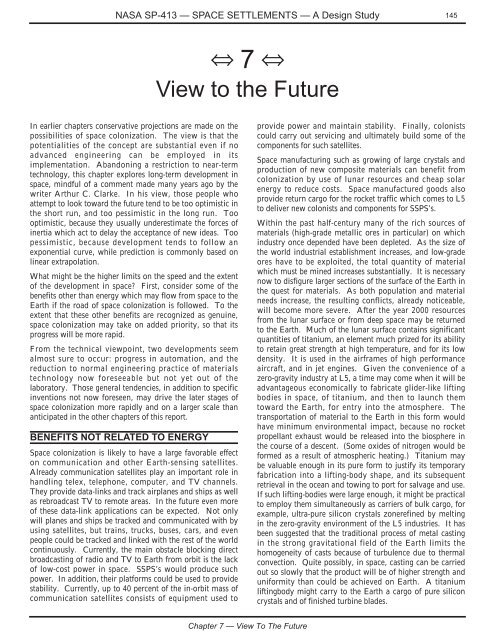NASA SP-413 Space Settlements - Saint Ann's School
NASA SP-413 Space Settlements - Saint Ann's School
NASA SP-413 Space Settlements - Saint Ann's School
You also want an ePaper? Increase the reach of your titles
YUMPU automatically turns print PDFs into web optimized ePapers that Google loves.
<strong>NASA</strong> <strong>SP</strong>-<strong>413</strong> — <strong>SP</strong>ACE SETTLEMENTS — A Design Study<br />
145<br />
⇔ 7 ⇔<br />
View to the Future<br />
In earlier chapters conservative projections are made on the<br />
possibilities of space colonization. The view is that the<br />
potentialities of the concept are substantial even if no<br />
advanced engineering can be employed in its<br />
implementation. Abandoning a restriction to near-term<br />
technology, this chapter explores long-term development in<br />
space, mindful of a comment made many years ago by the<br />
writer Arthur C. Clarke. In his view, those people who<br />
attempt to look toward the future tend to be too optimistic in<br />
the short run, and too pessimistic in the long run. Too<br />
optimistic, because they usually underestimate the forces of<br />
inertia which act to delay the acceptance of new ideas. Too<br />
pessimistic, because development tends to follow an<br />
exponential curve, while prediction is commonly based on<br />
linear extrapolation.<br />
What might be the higher limits on the speed and the extent<br />
of the development in space? First, consider some of the<br />
benefits other than energy which may flow from space to the<br />
Earth if the road of space colonization is followed. To the<br />
extent that these other benefits are recognized as genuine,<br />
space colonization may take on added priority, so that its<br />
progress will be more rapid.<br />
From the technical viewpoint, two developments seem<br />
almost sure to occur: progress in automation, and the<br />
reduction to normal engineering practice of materials<br />
technology now foreseeable but not yet out of the<br />
laboratory. Those general tendencies, in addition to specific<br />
inventions not now foreseen, may drive the later stages of<br />
space colonization more rapidly and on a larger scale than<br />
anticipated in the other chapters of this report.<br />
BENEFITS NOT RELATED TO ENERGY<br />
<strong>Space</strong> colonization is likely to have a large favorable effect<br />
on communication and other Earth-sensing satellites.<br />
Already communication satellites play an important role in<br />
handling telex, telephone, computer, and TV channels.<br />
They provide data-links and track airplanes and ships as well<br />
as rebroadcast TV to remote areas. In the future even more<br />
of these data-link applications can be expected. Not only<br />
will planes and ships be tracked and communicated with by<br />
using satellites, but trains, trucks, buses, cars, and even<br />
people could be tracked and linked with the rest of the world<br />
continuously. Currently, the main obstacle blocking direct<br />
broadcasting of radio and TV to Earth from orbit is the lack<br />
of low-cost power in space. S<strong>SP</strong>S’s would produce such<br />
power. In addition, their platforms could be used to provide<br />
stability. Currently, up to 40 percent of the in-orbit mass of<br />
communication satellites consists of equipment used to<br />
provide power and maintain stability. Finally, colonists<br />
could carry out servicing and ultimately build some of the<br />
components for such satellites.<br />
<strong>Space</strong> manufacturing such as growing of large crystals and<br />
production of new composite materials can benefit from<br />
colonization by use of lunar resources and cheap solar<br />
energy to reduce costs. <strong>Space</strong> manufactured goods also<br />
provide return cargo for the rocket traffic which comes to L5<br />
to deliver new colonists and components for S<strong>SP</strong>S’s.<br />
Within the past half-century many of the rich sources of<br />
materials (high-grade metallic ores in particular) on which<br />
industry once depended have been depleted. As the size of<br />
the world industrial establishment increases, and low-grade<br />
ores have to be exploited, the total quantity of material<br />
which must be mined increases substantially. It is necessary<br />
now to disfigure larger sections of the surface of the Earth in<br />
the quest for materials. As both population and material<br />
needs increase, the resulting conflicts, already noticeable,<br />
will become more severe. After the year 2000 resources<br />
from the lunar surface or from deep space may be returned<br />
to the Earth. Much of the lunar surface contains significant<br />
quantities of titanium, an element much prized for its ability<br />
to retain great strength at high temperature, and for its low<br />
density. It is used in the airframes of high performance<br />
aircraft, and in jet engines. Given the convenience of a<br />
zero-gravity industry at L5, a time may come when it will be<br />
advantageous economically to fabricate glider-like lifting<br />
bodies in space, of titanium, and then to launch them<br />
toward the Earth, for entry into the atmosphere. The<br />
transportation of material to the Earth in this form would<br />
have minimum environmental impact, because no rocket<br />
propellant exhaust would be released into the biosphere in<br />
the course of a descent. (Some oxides of nitrogen would be<br />
formed as a result of atmospheric heating.) Titanium may<br />
be valuable enough in its pure form to justify its temporary<br />
fabrication into a lifting-body shape, and its subsequent<br />
retrieval in the ocean and towing to port for salvage and use.<br />
If such lifting-bodies were large enough, it might be practical<br />
to employ them simultaneously as carriers of bulk cargo, for<br />
example, ultra-pure silicon crystals zonerefined by melting<br />
in the zero-gravity environment of the L5 industries. It has<br />
been suggested that the traditional process of metal casting<br />
in the strong gravitational field of the Earth limits the<br />
homogeneity of casts because of turbulence due to thermal<br />
convection. Quite possibly, in space, casting can be carried<br />
out so slowly that the product will be of higher strength and<br />
uniformity than could be achieved on Earth. A titanium<br />
liftingbody might carry to the Earth a cargo of pure silicon<br />
crystals and of finished turbine blades.<br />
Chapter 7 — View To The Future
















